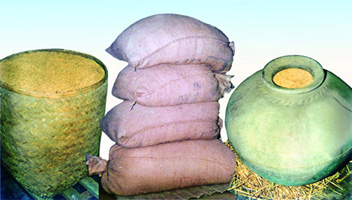Grain Storage
Grain Storage the major cereal grains in Bangladesh are rice, wheat and maize. These cereals are often kept in storage for a considerable period. The level of avoidable post-harvest losses of stored cereal grain in Bangladesh is still unacceptably high and varies from 10 to 25%. The loss occurs partly due to insect and fungal attack during storage. Reducing post-harvest losses depends on proper threshing, cleaning, drying, and storage.

Drying is the removal of excess moisture content from the grains to an appropriate level. Cereal grains in Bangladesh are dried through traditional method of sun drying. In this method, moist crops are spread on a flat surface, commonly of beaten earth, directly in the sun's rays for a certain time.
The high temperature dryers used in developed countries are not economically viable in Bangladesh. Since all areas of the country receive abundant solar radiation, the solar drying method is universally used here.
However, solar dyers have great potential, since solar drying appears environmentally sound and pollution free. For small-scale seed production, mechanical dryer/solar assisted dryer, and for large-scale seed production, batch type drying and storage systems appear to be promising propositions for Bangladesh. The primary aim of storage is to prevent deterioration of the quality of the grain. This is not done directly, but indirectly through control of moisture and air movement, and by preventing infestation of microorganisms, and attacks of insects and rodents.
In Bangladesh cereal grains are stored by farmers to meet their own consumption and for seeds. The produce thus retained is estimated to vary from 10 to 100% of the production. The average retention is about 70% of the produce. Cereal grains are stored either in containers or in bulk. The containers in Bangladesh include matka or large earthen pots, jute bags etc, whereas the grains are stored in traditional storage spaces, such as conventional godowns, warehouses, and silos. About 90% of the available storage is done in bulk.
Rural storage of cereal grains accounts for about 80% of the produce and is accomplished in traditional storage systems. The techniques used in traditional storage are embedded in custom and has passed down through generations. The type of foodstuff and size of the crops determine the design and capacity of these facilities. There are about eight different types of storage systems used at the farm level in Bangladesh. Among these, dhangola (medium and large sized cylindrical or rectangular bin), bed (cylindrical medium capacity bin), and dole (small capacity cylindrical bamboo-made structure) are common types of storage systems. Among bamboo structures, the most commonly used ones are dole and bed. The dole has a bottom as an integral part of it, but the bed and dhangola do not. The common size of dole is about 0.6 m in diameter and 1 m in height, and the capacity is 240 to 450 kg. The bed is about 1.5 m in height and 1.5 m in diameter, and its capacity is 700 to 1200 kg. The rectangular dhangola is about 7 m in length, 3.5 m in width and 3 m in height, and its capacity is 4000 to 40,000 kg. The dhangola is stronger in construction and more costly than either bed or dole. Experimental studies show that all these three types of bins are suitable for storage of seeds of paddy from harvesting to sowing and that the dole is the best among the three. The optimum capacity of the bed and dole are 2450 kg and 750 kg, respectively.
Bagged grains are stored in flat warehouses, which are often called 'conventional godowns'. Bagged food grain storage system includes the local storage depots (in rural and urban district areas) and the central storage depots (at regional levels). The local and central depots are used for short-term storage of food grains. These food grains are either procured from farmers during the harvesting season or received from other local and central storage depots and silos. Moreover, grains imported for distribution to other local and central storage depots, and ration shops are also stored in them. Silos are used for the storage of cereal grains, especially wheat, and as food security for emergency use in Bangladesh. [BK Bala]
